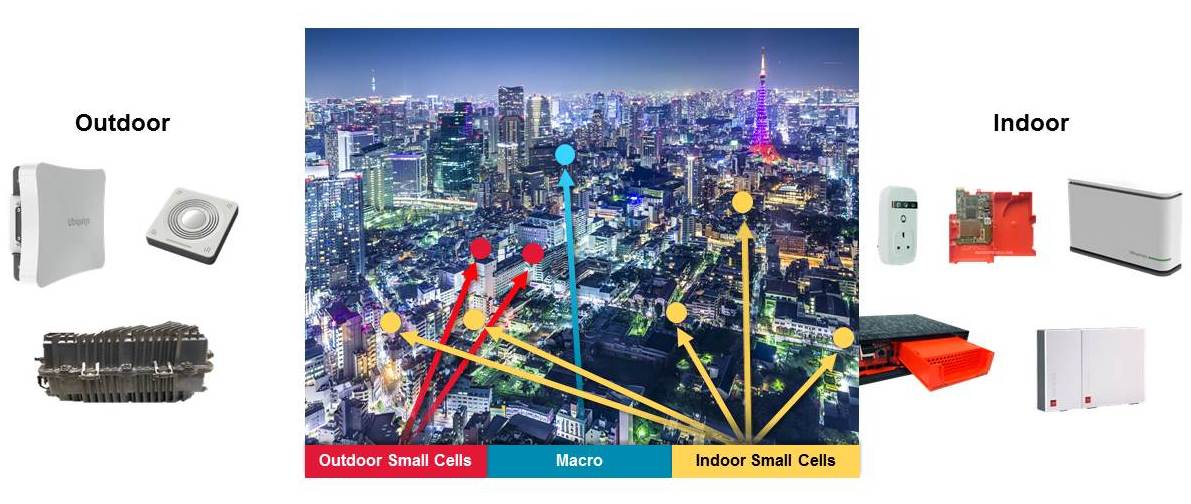A recent forecast predicts an eleven-fold increase in mobile data traffic by 2018. And more than half of the 190 exabytes of data expected to be flowing over the wireless network, will be carried over 4G/LTE networks.
As current 3G networks reach peak capacity, 4G/LTE deployments promise to expand performance to increasingly higher levels. While consumers will reap the reward of that expansion, carriers must make significant changes to their current networks. In addition to rolling out faster 4G/LTE service today, carriers must invest significantly in network infrastructure to deliver the greater bandwidth and faster speeds essential for connecting the more than 30 billion wirelessly connected devices anticipated by 2020. And, while there’s no question that LTE can deliver faster speeds and reduced latency to bandwidth-hungry users, LTE itself requires two precious resources to deliver: Time, and a lot of spectrum. Enter the small cell.
Small cells are cost-effective devices with increased deployment density that essentially act as local access roads to help seamlessly offload data traffic from macro to micro wireless networks. When used in combination with other wireless access network technologies, such as macrocells and Wi-Fi offloading, small cells provide better cellular and wireless coverage for end users - while at the same time helping service providers better manage data traffic and spectrum.
Small cells are categorized into three different location-centric categories: Residential for home applications, enterprise/indoor for small business or retail applications, and outdoor for users in public spaces. They can operate in both licensed and unlicensed spectrum over a range of of hundreds of meters in urban areas as compared to kilometers in rural areas.

Consider the case of an LTE macro cell capable of a 150-Mbps downlink over 20 MHz, without carrier aggregation. A small cell could achieve the same downlink in the same bandwidth. Of course, the average number of users for a macrocell is a few hundred, while the number of users for a small cell is generally less than 100, meaning the small cell can deliver higher throughput in a denser area for each of the users.
By deploying low-cost small cells in the 4G LTE network, carriers can fill in dead spots, beef up coverage in congested areas and provide better quality of service for enterprises. Given their low cost and compact design, small cells can be deployed virtually anywhere additional capacity and coverage is needed, such as in a shopping mall or public arena.
Just imagine a beautiful weekend afternoon and a large crowd of people gathered at a local park for a gourmet food festival. Because virtually everyone these days is dialed into social media, many attendees might be busy on their smartphones while waiting for or consuming their food. At best, the resulting data crunch on the 4G/LTE cellular network would simply slow down service; at worst, it could cut the connection altogether.
But if a small cell was added to the picture—say mounted on the wall of a nearby office building—the station could pump out enough bandwidth to easily connect the smartphones in the park trying to maintain a data connection, offloading the traffic from the cellular network and improving connectivity for everyone in the area.
Of course, small cells not only offload traffic from the 4G/LTE cellular network, they can also help extend capacity in hard-to-reach locations and indoor sites. This is an important point since the higher frequencies associated with much of the new LTE spectrum can actually reduce coverage—particularly indoors.
At the end of the day, adding small cells into the 4G/LTE network means improved connectivity, whether in a public space, a home or an office. But small cells do face some challenges of their own. In urban small cell deployments, carriers will need to deal with having many different phones, operating at different velocities and a lack of suitable sites for cell placement. In public outdoor deployments, network interference between outdoor small cells and macro cells will need to be managed and a method for seamless hand-offs between macro and small cells identified. Operators and carriers will also need to define a continuous process in the network for monitoring and tuning small cell configurations as a function of users’ traffic.
As these challenges are successfully confronted, small cells promise to be an invaluable addition to the 4G/LTE network.
 Greg Fischer serves as Senior Vice President & General Manager of Broadband Carrier Access at Broadcom Corporation. In this role he is responsible for driving Broadcom's vision for carrier access semiconductor solutions, enabling wireline and wireless broadband services to and throughout the home, with end products and end markets focused on providing complete xDSL , FTTx and wireless access solutions for advanced central office (CO) and customer premises equipment (CPE) applications.
Greg Fischer serves as Senior Vice President & General Manager of Broadband Carrier Access at Broadcom Corporation. In this role he is responsible for driving Broadcom's vision for carrier access semiconductor solutions, enabling wireline and wireless broadband services to and throughout the home, with end products and end markets focused on providing complete xDSL , FTTx and wireless access solutions for advanced central office (CO) and customer premises equipment (CPE) applications.
Prior to Broadcom, Fischer served in a variety of executive various roles with Conexant Systems, a semiconductor manufacturer, including Vice President of Marketing, and Vice President & General Manager of the Video Products Group. Fischer holds a B.S.E.E. degree from the Milwaukee School of Engineering and an M.B.A. from University of Iowa. Contact the author @broadcom
Edited by
Stefania Viscusi  QUICK LINKS
QUICK LINKS